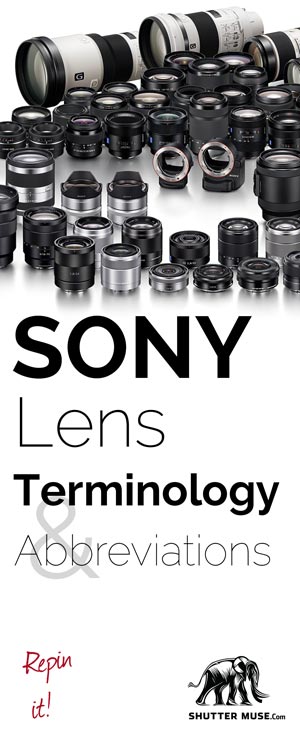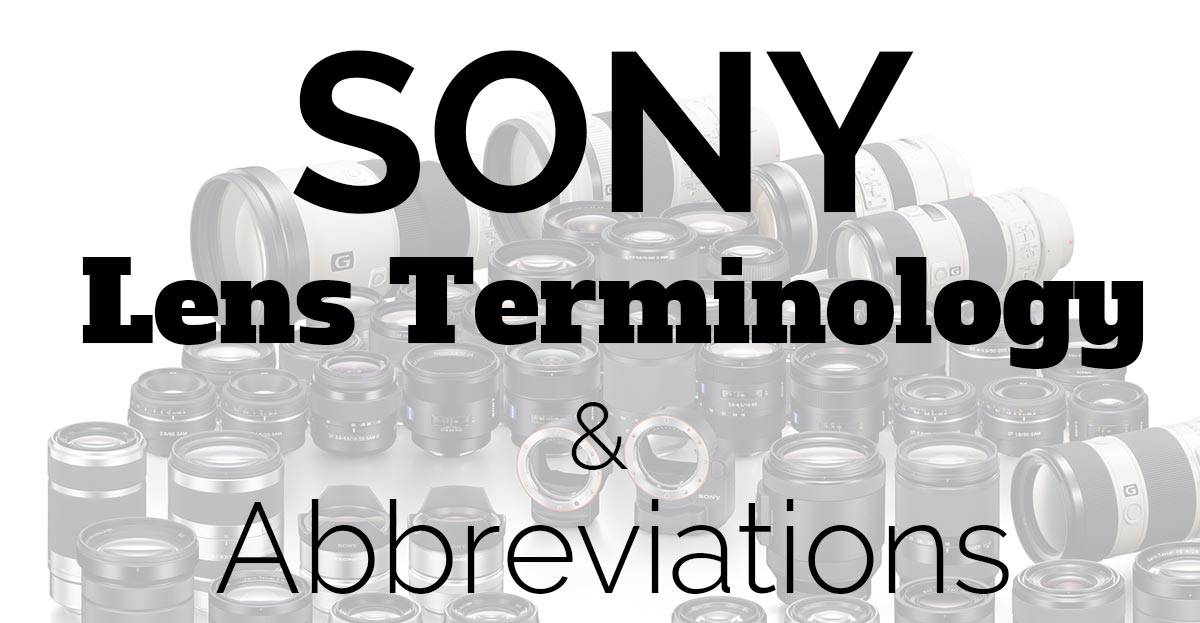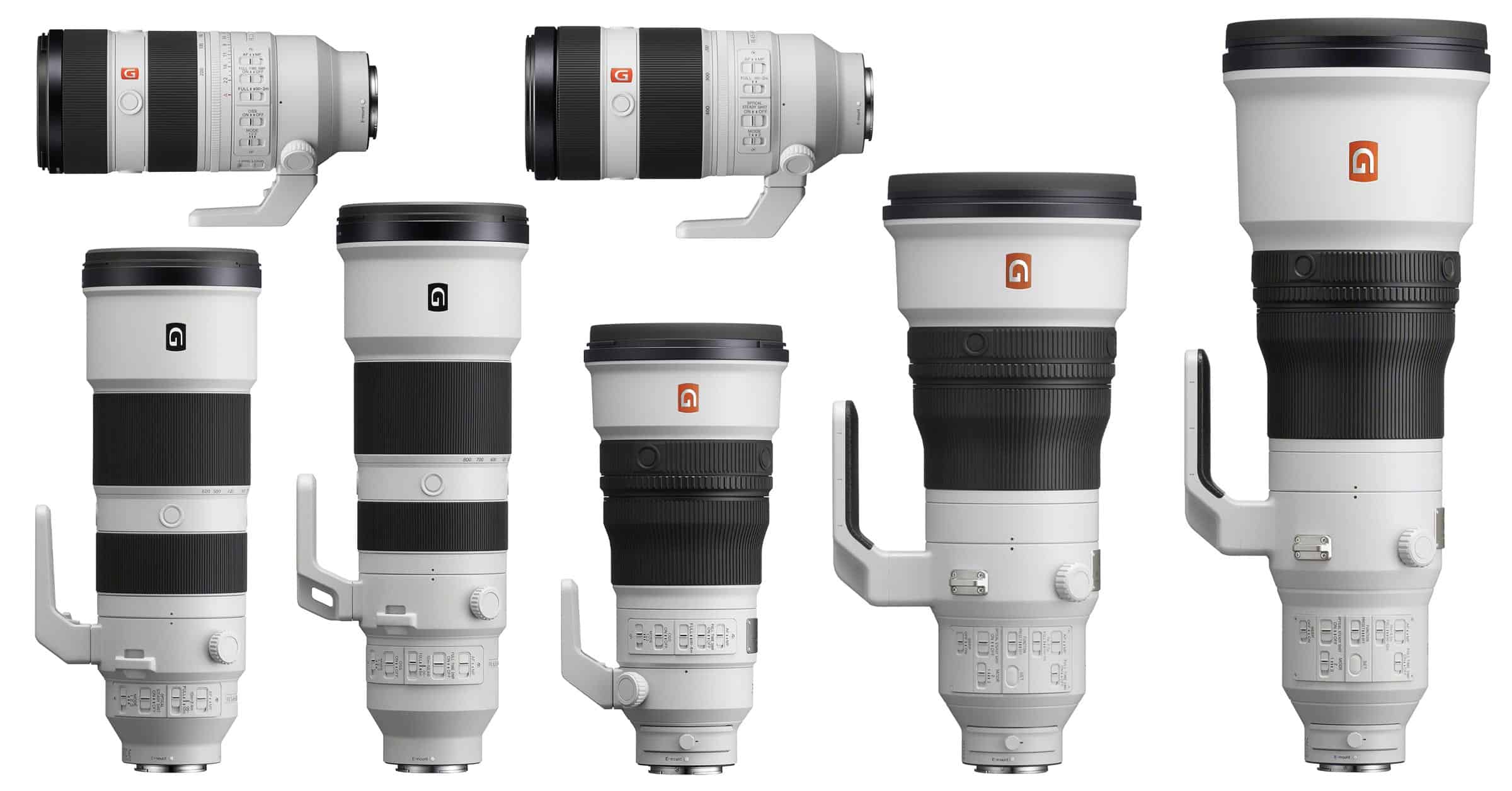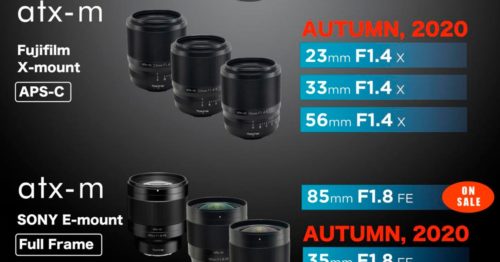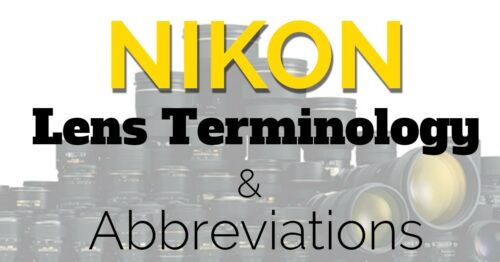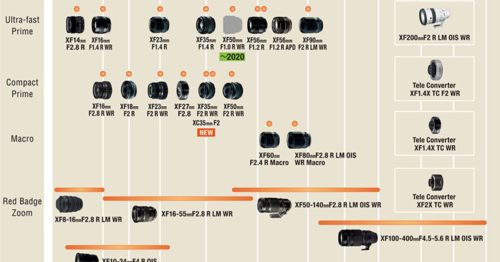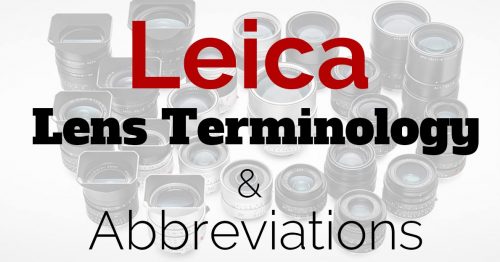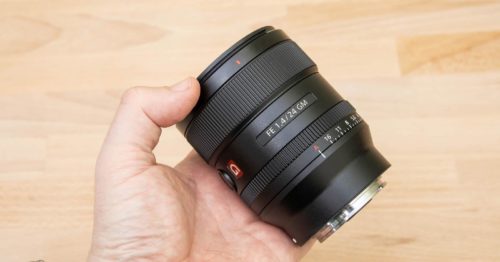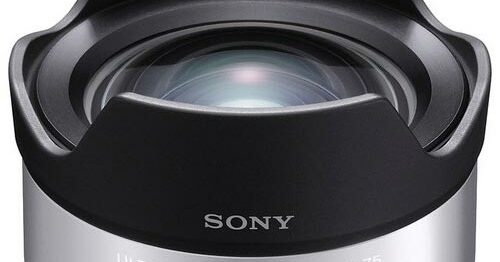From the outside looking in, the world of Sony lenses can appear extremely confusing. Sony is a relative newcomer to the photography industry, having released their first ‘Cyber-shot’ fixed lens compact in 1996. Unlike both Canon and Nikon, Sony did not start life as a camera or optics business, they began life manufacturing radios and tape-recorders.
This difference in initial direction and relatively late entry into the camera industry meant that Sony had to look outside their own capabilities in order to gain lost ground on competitors, and eventually become one of the ‘Big Three’ manufacturers in the business.
Of equal importance, and equally confusing is Sony’s close relationship with renowned German lens manufacturer Carl Zeiss. Zeiss independently manufactures lenses for Sony’s mounting systems and Sony also manufacture Zeiss branded lenses. It is important to realise that these are not the same thing. Sony manufactured, Zeiss branded lenses use Zeiss ‘approved’ optical formulae and technology, but are built by Sony; Zeiss manufactured lenses for Sony cameras are built by Zeiss. Today we will be looking at Sony’s ‘in-house’ lenses.
Confused yet? Let’s see if we can unravel a few things!
Table of Contents
Sony Lens Mounts
Sony E-Mount Lenses
The E-mount is the lens mounting system for Sony’s mirrorless camera systems. It first appeared in 2010 on Sony’s NEX line of APS-C sensor mirrorless cameras. In 2010 Sony released the A7 full-frame mirrorless camera and the E-mount was expanded to include full-frame specific lenses. There is physically no difference between the APS-C and full-frame E-mount itself, the lenses are simply designed to resolve different image sizes. Sony uses this “one mount” system as a selling point and differentiator from its competitors.
APS-C E-Mount Lenses

Originally, APS-C format E-mount lenses carried no specific designation, as all original E-mount lenses were in fact designed to be used on APS-C bodies; If an E-mount lens does not carry the distinguishing acronym ‘FE’ (see below) then it can be assumed that it resolves an image the size of an APS-C sized sensor. APS-C E-mount lenses can be mounted on full-frame bodies, but the camera must be instructed to crop the image to compensate for the smaller image coverage area. Newer cameras can detect this and make the change automatically.
More recently, Sony has begun to differentiate the APS-C lenses from the full frame lenses in the lens names by referring to them as E lenses, while the full frame lenses are referred to as FE lenses. So, the Sony E 16-55mm f/2.8 G lens is designed for APS-C cameras.
Most popular APS-C E-Mount lenses: Sony E 16-55mm f/2.8 G | Sony E 70-350 f/4.5-6.3 G | Sony E 10-20mm f/4 G PZ | Sony E 11mm f/1.8 | Sony E 15mm f/1.4 G
Full-Frame ‘FE’ E-Mount Lenses

E-mount lenses with the acronym ‘FE’ in the model name are designed to resolve an image the size of a 35mm full-frame sensor. Although the lens will also be labelled E-mount on the barrel, ‘FE’ will be printed before the lens model name. FE lenses can be mounted on APS-C E-mount bodies with a change in the field of view from the original specification.
Most popular FE E-Mount lenses: Sony FE 24-70mm f/2.8 GM II | Sony FE 70-200mm f/2.8 GM II | Sony 20mm f/1.8 G | Sony 200-600mm f/5.6-6.3 G OSS | Sony 100-400mm f/4-5.6 GM OSS
Sony A-Mount
Today, in basic terms, Sony ‘A-mount’ lenses were designed to be used on the company’s line of digital SLT or ‘Single Lens Translucent Cameras’. SLT cameras use a fixed translucent mirror which allows a portion of the light entering through the lens through to the sensor, whilst reflecting the remaining light onto the camera’s phase-detect autofocus sensor.
The Sony A-mount first appeared in 2006 when Sony Acquired the assets of Konica Minolta, including the Minolta AF lens mount for SLR cameras. The technology was rebranded and became the Sony A-mount system. The first actual appearance of the mount design however was in 1985; The Konica Minolta ‘A-type bayonet mount as it was then called, was in fact the world’s first fully-integrated SLR autofocus lens system. Minolta A-type lenses are compatible with Sony A-mount bodies and Sony A-mount lenses can be mounted on Minolta SLRs with a loss of some functionality. The Sony A-Mount system was officially discontinued in 2021.
Full Frame A-Mount Lenses
In 2008 Sony released the α900 full-frame DSLR. Full frame A-mount lenses carry no specific distinction in the lens model name, therefore all A-mount lenses without ‘DT’ in the model name resolve an image the size of a 35mm full frame sensor. Full frame A-mount lenses are compatible with both full frame and APS-C bodies with a change in the lens field of view.
Most popular A-Mount lenses: Sony 50mm f/1.4 Carl Zeiss Planar T* ZA | Sony 24-70mm f/2.8 ZA SSM II Vario-Sonnar T* | Sony 70-200mm f/2.8 G SSM II | Sony 16-35mm f/2.8 ZA SSM II Vario-Sonnar T*
‘DT’ A-Mount Lenses
Initially, Sony A-mount lenses (circa 2006) were made for APS-C format DSLRs (Sony started using DSLTs in 2010) and were mostly rebranded Minolta lenses. A-mount lenses designed for APS-C sensors are designated by the acronym ‘DT’ or ‘Digital Technology’ in the lens model name and printed on the lens barrel. DT lenses are compatible with APS-C and full-frame bodies; Full-frame cameras must, however, be instructed to crop the image to compensate for the smaller image coverage area. The DT lenses were first introduced in 2005 by Minolta.
Most popular DT A-Mount lenses: Sony 55-300mm f/4.5-5.6 DT | Sony 16-50mm f/2.8 DT | Sony 50mm f/1.8 DT
PL-Mount lenses
Now discontinued, Sony manufactured a small number of lenses that used the cinema industry-standard PL-mount system. These lenses were originally launched for use on Sony’s own CineAlta range of cinema cameras. Sony PL lenses came in two forms: The expensive professional Sony SCL-P11X15 11-16mm T3.0 cost over $7000, and the ‘budget’ series of PL prime lenses cost over $12000 for the set!
Most popular PL lenses: CineAlta 4k Prime 6 Lens Set | Sony SCL-P11X15 11-16mm T3.0 | CineAlta 4k Prime 3 Lens Set
Sony Lens Types
‘G’ Gold Lenses
Sony ‘G’ or Gold lenses once represented the pinnacle of Sony’s optical imaging technology. Originally using adapted and refined Konica Minolta optical designs, they were re-engineered to meet Sony’s exacting standards. G lenses are made from superior materials, exhibiting superior handling, excellent image sharpness and beautifully soft out of focus areas. G lenses generally feature excellent low light performance and use only the finest optical elements to limit distortion and aberration.
The ‘G’ moniker was first started by Minolta, but confusingly, the letter was never actually written externally on any of what they considered to be the G-series Minolta lenses. Sony G-lenses were first released in 2006 for the A-mount system, the Sony α 70-200mm f/2.8 G SSM and Sony α 300mm f/2.8 G SSM being the first two lenses to carry the ‘G’ designation.
In 2013, the release of the Sony E PZ 18-105mm F4 G OSS heralded the arrival of the first E-mount ‘G’ lens. All G-lenses feature a white or silver G on a matt black background embossed on the lens barrel. The subsequent release of the first ‘GM’ lenses (see below) now makes G lenses Sony’s second tier of professional quality lenses.
Most popular G lenses: Sony FE 200-600 f/5.6-6.3 G OSS| Sony 20-70mm f/4 G | Sony 70-200mm f/4 G II Macro OSS | Sony 20mm f/1.8 G | Sony FE 90mm f/2.8 Macro G OSS | Sony 400-800mm f/6.3-8 G | Sony 16mm f/1.8 G
‘GM’ G Master Lenses
First released in 2016, Sony GM or G-Master lenses represent the new pinnacle of Sony’s lens technology, they are the direct descendant of Sony’s G-lenses, updated to meet the stringent requirements of Sony’s new breed of hyper-capable full-frame mirrorless E-mount cameras. G-Master lenses feature the highest quality optics, including XA ‘extreme aspherical elements and advanced AR lens coatings.
All G-master lenses are weather and dust sealed for durability. Each G-Master lens is individually calibrated to make sure it will resolve images of the highest possible quality. G-Master lenses are identifiable by a white ‘G’ on a matt red background embossed on the lens barrel. Expect to pay no big money for a GM lens!
Most popular GM lenses: Sony FE 24-70mm f/2.8 GM II | Sony FE 70-200mm f/2.8 GM II | Sony FE 50 mm F1.4 GM | Sony FE 16-35mm f/2.8 GM II | Sony FE 100-400 f/4.5-5.6 GM | Sony FE 24mm f/1.4 GM | Sony 12-24mm f/2.8 GM | Sony 85mm f/1.4 GM II
Macro Lenses
Sony macro lenses are specifically designed for macro or close-up photography. A good Macro lens should feature a 1:1 magnification ratio for taking highly detailed, life-sized images of subjects, and be able to focus on subjects extremely close to the camera. The first Sony macro lens was the Sony α Macro 50mm f/2.8, released in 2006. Sony macro lenses are available in A-mount, DT A-mount, E-Mount and FE E-mount formats.
Most popular Macro lenses: Sony 70-200mm f/4 G II Macro | Sony FE 90mm f/2.8 Macro G OSS | Sony FE 50mm f/2.8 Macro
Sony Smooth Transition Focus Lens
Sony’s STF or ‘Smooth Transition Focus Lens’ is actually a rebranded version of the technology first seen in the Minolta 135mm F2.8 T4.5 STF. This lens uses an APD ‘apodization element,’ which, in simple terms, is a type of ND filter that becomes thicker towards its edges. The gradual thickening of the element limits the amount of light allowed to transition the lens progressively toward the edges of the image area, resulting in a smoother bokeh fall-off.
Only STF lens: Sony 100mm f/2.8 STF GM OSS |
CineAlta Lenses
As mentioned in the above PL-mount section, CineAlta lenses were specifically designed to be used with Sony’s CineAlta cinema camera system. Sony CineAlta lenses were manual focus only. The CineAlta lens system consisted of one zoom and six primes. All CineAlta lenses have now been discontinued.
Most popular CineAlta lenses: CineAlta 4k Prime 6 Lens Set | Sony SCL-P11X15 11-16mm T3.0 | CineAlta 4k Prime 3 Lens Set
Sony Zeiss Lenses
Once again things become a little murky. Sony Zeiss lenses are manufactured by Sony but utilize Zeiss approved lens designs. Sony Zeiss lenses are extremely high-quality lenses featuring aspherical, advanced aspherical and ED elements, and all feature Zeiss’s T* anti-reflective coating. They feature high qualities of construction and are identifiable by the blue and white Zeiss logo embossed on the lens Barrel. Sony Zeiss lenses always have the acronym ‘ZA’ in the lens model name and a ‘Z’ in the Sony product number. ‘Vario’ Zeiss lenses are Zeiss approved zoom lens designs.
In the beginning, it made a lot of sense for Sony to work closely with Zeiss. However, Sony has since developed the skills to create incredible lenses on their own. With a growing range of G and GM lenses in the lineup, many of which are praised as “world’s best”, it seems unlikely that there will be any future Sony Zeiss lenses.
Most popular Sony Zeiss lenses: Sony Sonnar T* FE 55mm f/1.8 ZA | Sony Vario-Tessar T* FE 16-35mm f/4 ZA OSS | Sony Vario-Tessar T* E 16-70mm f/4 ZA OSS | Sony Sonnar T* FE 35mm f/2.8 ZA
Sony Zeiss Sonnar
The Sony Zeiss Sonnar lenses are manufactured by Sony, but utilize the classic Zeiss ‘Sonnar’ lens formula. The Sonnar lens formula first appeared in 1929 and is characterized by a simple arrangement of elements, coupled with a fast aperture, producing high-quality images with excellent contrast and low levels of flare. They were originally released in A-mount 35mm format and are now also available in A-Mount DT format, E-mount and FE E-mount.
Most popular Sony Zeiss Sonnar lenses: Sony Carl Zeiss Sonnar T* FE 35mm F2.8 ZA | Sony Carl Zeiss Sonnar T* FE 55mm F1.8 ZA | Sony Carl Zeiss Sonnar T* E 24mm F1.8 ZA
Sony Zeiss Planar
Once Again, manufactured by Sony, but using the Zeiss ‘Planar’ lens formula. The Zeiss Planar design can be traced back as far as 1896 and it is now said that nearly every 50mm prime lens in existence uses a design that is essentially a modified Planar formula. Planar lenses are characterised by a symmetrical element layout with the aperture placed between the element groups. This layout allows for wider apertures to be employed and produces extreme edge to edge sharpness and little chromatic aberration. There is currently one FE format Sony Zeiss Planar and two 35mm format A-mount Sony zeiss Planar lenses
All three Sony Zeiss Planar Lenses:
Most popular Sony Zeiss Planar lenses: Sony Zeiss Planar T* FE 50mm F1.4 ZA | Sony α Carl Zeiss Planar T* 85mm f/1.4 ZA | Sony α Carl Zeiss Planar T* 50mm f/1.4 ZA SSM
Sony Zeiss Distagon
The Zeiss Distagon formula can be traced back to 1953 and is the name given to a complex Zeiss formula used to produce wide-angle lenses. Distagon lenses are large and relatively heavy, they are also extremely complex in nature but produce fantastic image quality. There are two Sony Zeiss Distagon lenses, the Sony Zeiss Distagon T* FE 35mm F1.4 ZA for FE format E-mount and the Sony α Carl Zeiss Distagon T* 24mm f/2 ZA SSM for 35mm format A-Mount.
Most popular Sony Zeiss Distagon lenses: Sony Carl Zeiss Distagon T* 24mm f/2 ZA SSM | Sony Zeiss Distagon T* FE 35mm F1.4 ZA.
Abbreviations and Acronyms
OSS
OSS stands for ‘Optical SteadyShot’ and is the name of Sony’s optical image stabilization system. It is found on E-mount lenses; A-mount lenses don’t use OSS because the A-mount camera system uses sensor based image stabilization. OSS lenses feature the acronym OSS in the lens model name and sometimes have ‘Optical SteadyShot’ embossed on the lens barrel.
Most popular OSS lenses: Sony 300mm f/2.8 GM OSS | Sony FE 70-200mm f/2.8 GM OSS II | Sony 70-200mm f/4 G OSS II Macro | Sony FE 90mm f/2.8 Macro G OSS | Sony FE 200-600mm f/5.6-6.3 G OSS
II or “Mark 2”
Sony lenses with the double-i at the end of their names use the Roman numeral “II” to indicate that they are the Mark 2 version of that lens. These newer lenses are usually slightly smaller and lighter than the original version while also containing superior optics and autofocus motors. Sony doesn’t have a predictable timeline for redesigning its lenses and issuing a Mark 2 version.
That said, the gap between the original 85mm f/1.4 GM and the 85mm f/1.4 GM II was eight years, and the gap between the original 16-35mm f/2.8 GM and the GM II version was six years, so you can expect it to be somewhere in that region. If you’re curious, we have a list of Sony lens release dates in another article.
Most popular Mark II lenses: Sony FE 70-200mm f/2.8 GM OSS II | Sony 70-200mm f/4 G OSS II Macro | Sony 24-70mm f/2.8 GM II | Sony 85mm f/1.4 GM II | Sony 16-35mm f/2.8 GM II
XD Linear Motor
XD LM stands for Extreme Dynamic Linear Motor. This new autofocus motor system was first introduced with the FE135mm GM lens and subsequently used in all G-Master lenses released after that point. Linear motors use a contactless electromagnetic drive system that is incredibly quiet. The XD LMs were designed to deliver higher thrust to accommodate the larger lens elements of super-telephoto lenses, as well as higher element velocity to match the faster autofocus calculation speeds that began to appear in the Sony Alpha camera lineup with the a9, and subsequently the a9 II and a1. The video below shows the mechanism in action.
Most popular lenses with XD Linear Motors: Sony 300mm f/2.8 GM OSS | Sony FE 70-200mm f/2.8 GM OSS II | Sony 70-200mm f/4 G OSS II Macro | Sony 50mm f/1.4 GM | Sony 135mm f/1.8 GM
PZ

‘Power Zoom’ or PZ lenses feature a built-in electronic zoom motor, which can be used to control the lenses’ optical zoom. The system uses a barrel-mounted zoom rocker to control the zoom speed and amount. PZ Lenses are suited to video use because they provide smooth, silent, constant rate zoom during recording. PZ lenses can be most easily identified by the zoom rocker on the barrel, labeled W/T for Wide/Tele.
Most popular PZ lenses: Sony E 10-20m f/4 G PZ | Sony FE PZ 16-35mm f/4 G
XA
Lenses with an XA or ‘Extreme Aspherical’ element feature an aspherical element (see above) manufactured to extremely high tolerances, Sony claims surface precision of 0.01 microns. XA lenses produce extremely high resolution lenses with beautiful out of focus elements. Currently only the GM lenses feature XA elements.
All three G-Master lenses feature XA elements: Sony FE 16-35mm f/2.8 GM II | Sony FE 70-200mm f/2.8 GM II | Sony FE 50 mm F1.4 GM | Sony 12-24mm f/2.8 GM
SAL
The Acronym SAL can be found in Sony’s own product numbers for autofocus lenses made for the A-mount system, for example the Sony product number for the Sony α Zeiss Vario-Sonnar T* 16-35mm f/2.8 ZA SSM II is SAL-1635Z2 – All current A-mount lens Sony product numbers begin with SAL.
SEL
Much like ‘SAL’ the abbreviation SEL is found in Sony’s product numbers for autofocus lenses designed for the E-mount mirrorless camera system, for example the Sony product number for the Sony FE 28mm F2 is SEL-28F20. All current E-mount lens Sony product number begin with SEL.
ZA
‘Zeiss Alpha’ or ZA lenses use Zeiss-approved optical formulae but are manufactured by Sony. They are typically high-quality lenses, rivaling Sony ‘G’ lenses in price and performance.
Most popular ZA lenses: Sony Sonnar T* FE 55mm f/1.8 ZA | Sony Vario-Tessar T* FE 16-35mm f/4 ZA OSS | Sony Vario-Tessar T* E 16-70mm f/4 ZA OSS | Sony Sonnar T* FE 35mm f/2.8 ZA
SSM
‘SuperSonic Motor’ or SSM lenses employ a ring-type piezoelectric motor to facilitate extremely fast, quiet and accurate autofocus. They include a distance scale which is built into the lens, underneath a transparent window, and feature full-time manual focus override. Some Sony lenses that features a SSM motor include the SSM acronym in the lens model name printed around the first element on the front of the barrel, some don’t, for example the Sony FE 85 mm F1.4 GM. Also as mentioned, feature the distance meter underneath a transparent window
Most popular SSM lenses: Sony 16-35mm f/2.8 ZA SSM Vario-Sonnar T* | Sony 70-200mm f/2.8 G SSM II | Sony 24-70mm f/2.8 ZA SSM II Vario-Sonnar T*
DDSSM

The DDSSM of ‘Direct Drive SuperSonic Motor first appeared in 2015 and is more powerful than SSM, designed to quickly move the large, heavy focus groups within full frame lenses. Whether a lens uses the SSM of DDSSM design can be very confusing. DDSSM, for example, is used on the Sony FE 90mm f/2.8 Macro G and the Sony Zeiss Distagon T 35mm f/1.4, neither advertising the fact on the lens barrel. DDSSM is also employed in the Mark 1 Sony FE 24-70 mm F2.8 GM, but the Mark 1 Sony FE 70-200mm F2.8 GM OSS and Sony FE 85 mm F1.4 GM both use standard SSM.
Most popular DDSSM lenses: Sony FE 24-70 mm F2.8 GM | Sony FE 90mm f/2.8 Macro G OSS | Sony Zeiss Distagon T* FE 35mm F1.4 ZA
SAM
‘Smooth Autofocus Motor’ or SAM equipped lenses employ a cheaper motor design than SSM or DDSSM (see above) to facilitate housing an autofocus motor within the lens body. SAM tends to be found in Sony’s cheaper lenses and kit lenses, they feature plastic barrels, plastic lens mounts, and the distance meter is embossed on the lens barrel. SAM lenses have the acronym SAM in the lens model name printed on the lens barrel.
Most popular SAM lenses: Sony 55-300mm f/4.5-5.6 DT | Sony 16-50mm f/2.8 DT | Sony 50mm f/1.8 DT
ED
ED indicates that a lens uses ‘Extra-low Dispersion’ glass, a technology that allows the production of lenses that significantly reduce chromatic aberration. Previously chromatic aberration was reduced by using calcium fluorite-based glass, but its brittle nature and temperature sensitivity has led to the development of more robust ED glass.
SCL
The acronym SCL appears in the Sony product number for Sony made PL-mount cinema lenses. Although i can’t find it confirmed anywhere, I assume it stands for ‘Sony Cinema Lens’.
T*
T* is only found in Sony ‘ZA’ lenses (see above) and designates that a lens uses Carl Zeiss T* coating technology. The T-Coating was developed by Alexander Smakula and patented in 1935. It is a multi-coat anti-reflective technology which greatly reduces the amount of inter element reflection within a lens, which can lead to a significant decrease in light transmission, and therefore lens performance. The process was further developed in the 1970’s and thereafter referred to as T*. T* Coating does not refer to a specific formula, with each type of lens design and glass requiring it’s own application to produce optimum optical performance. All Sony ZA lenses feature T* coating.
AR
Lenses featuring AR or ‘Anti-Reflective’ technology feature Sony’s own nano-coating technology to reduce inter-element reflection and promote light transmission. I can’t find any evidence of the acronym AR being included in the lens model name or printed on the lens barrel but all G and GM lenses feature Sony’s AR coating.
IF
IF or ‘Internal Focusing’ allows a lens to focus without altering its physical size. Focus is achieved by moving elements within the lens barrel. IF allows for lighter lens designs but can be challenging to design, therefore IF lenses tend to be much more expensive than their external focusing counterparts. Traditionally zoom lenses are even more challenging to make with IF as they already feature mobile elements to facilitate zooming. Sony however does manufacture a number of IF zoom lenses, the Sony Vario-Sonnar T* 16–35 mm F2.8 ZA SSM II and Sony 70-400mm F4-5.6 G SSM II both feature IF. All three GM lenses also feature IF. The acronym IF is not included in the lens model name, or printed on the lens barrel, if your zoom lens doesn’t extend when you zoom it has IF!
Pin This Post
